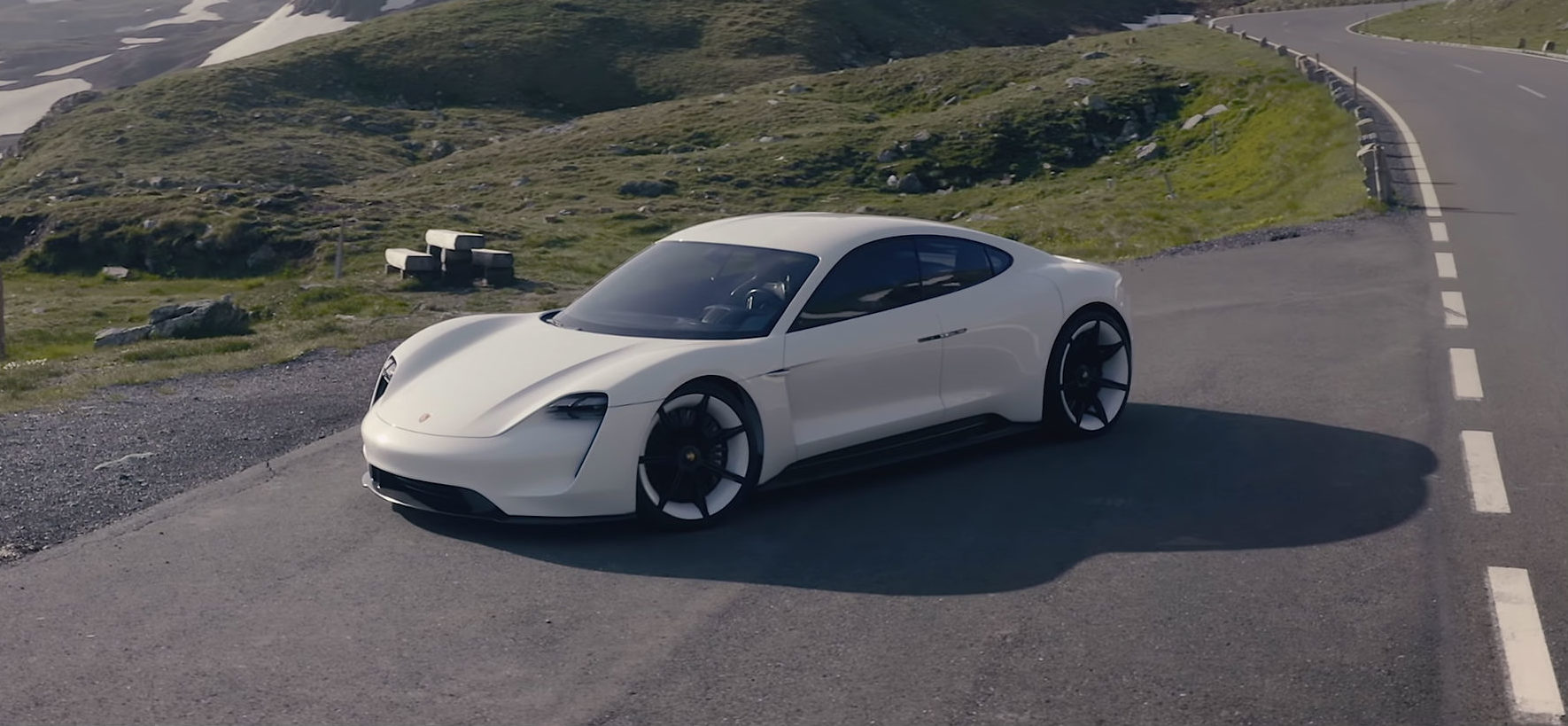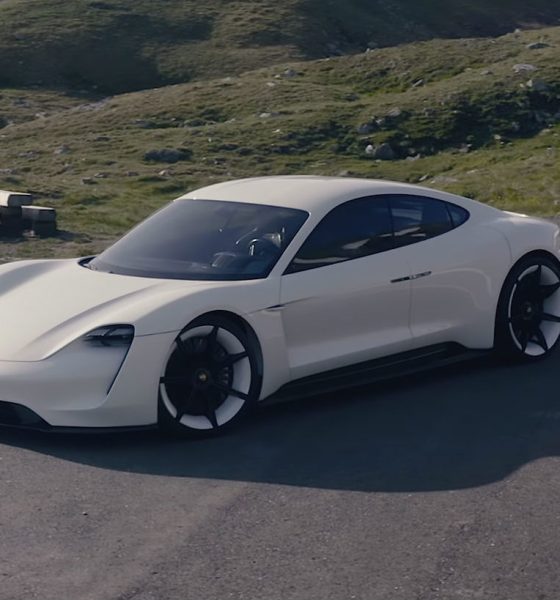

News
Porsche Taycan climbs Austria’s tallest mountain in new promotional video
The Porsche Taycan is still a year or so away from production, but the German automaker is already ramping its promotional efforts for the all-electric car. The company’s latest promotion for the Taycan featured a cinematic flourish, as the vehicle was showcased climbing Austria’s tallest mountain in an ad for the DJI Mavic 2, the drone company’s flagship “DSLR in the sky.”
The collaboration between Porsche and DJI featured the Taycan and a 550 Spyder traversing the twisting roads of the Grossglockner High Alpine Road (Großglockner mountain pass) in Austria, one of the country’s most picturesque routes. The Grossglockner High Alpine Road takes vehicles up 8,215 ft from the bottom to the top. The mountain pass, which features stunning vistas, is a popular site for auto enthusiasts, though it usually becomes inaccessible during winter and early spring due to snow and ice.
The concept of the commercial itself is symbolic of Porsche’s views on the Taycan. Porsche intends to eventually transition most of its fleet to electric cars and hybrid vehicles, and the Taycan is the car that could kickstart the change. The ad starts with aerial shots of the Porsche 550 Spyder, which eventually gets overtaken by the all-electric car. One of the close shots of the Taycan even featured what appears to be the audible sound of the vehicle’s electric motors as it climbed up the mountain pass.
The Taycan is all-electric, and it is equipped with two permanently excited synchronous motors (PSM), which Porsche dubs as the “turbos of the electric motor milieu.” The Taycan’s motors, which were used in the sports-prototype Porsche 919 Hybrid racing car, produce a combined 600 hp (440 kW), allowing the vehicle to accelerate from a dead stop to 60 mph in just 3.5 seconds. Just like the Model 3 Performance, the Taycan is also listed with a top speed of 155 mph, as well as a 310-mile range.
Porsche is one of the auto industry’s legacy carmakers that appears to be taking its electric car initiative seriously. Apart from its continued push of the Taycan, the company has also teased the release of the Mission E Cross Turismo, a variant of the vehicle that features off-road elements, in 2020. Porsche has also recently revealed that the Taycan would be supported by a fast-charging network not unlike Tesla’s Superchargers. Dubbed as Charge Parks, Porsche’s electric car stations would be placed on key locations across well-traveled routes, and it would provide drivers with a system that would allow the Taycan to replenish 248 miles of range in just 15 minutes.
The Porsche Taycan is expected to start production in 2019, though customers in the United States and selected territories can now pre-order the vehicle. The electric car is expected to be produced at Porsche’s Zuffenhausen facility in Stuttgart, Germany, the same facility where the Porsche 911, 718 Boxster, and the 718 Cayman are manufactured. Porsche plans to produce 20,000 Taycans annually when the electric car begins production.
Watch the Porsche Taycan climb Austria’s Grossglockner High Alpine Road in the video below.

News
Tesla starts showing how FSD will change lives in Europe
Local officials tested the system on narrow country roads and were impressed by FSD’s smooth, human-like driving, with some calling the service a game-changer for everyday life in areas that are far from urban centers.

Tesla has launched Europe’s first public shuttle service using Full Self-Driving (Supervised) in the rural Eifelkreis Bitburg-Prüm region of Germany, demonstrating how the technology can restore independence and mobility for people who struggle with limited transport options.
Local officials tested the system on narrow country roads and were impressed by FSD’s smooth, human-like driving, with some calling the service a game-changer for everyday life in areas that are far from urban centers.
Officials see real impact on rural residents
Arzfeld Mayor Johannes Kuhl and District Administrator Andreas Kruppert personally tested the Tesla shuttle service. This allowed them to see just how well FSD navigated winding lanes and rural roads confidently. Kruppert said, “Autonomous driving sounds like science fiction to many, but we simply see here that it works totally well in rural regions too.” Kuhl, for his part, also noted that FSD “feels like a very experienced driver.”
The pilot complements the area’s “Citizen Bus” program, which provides on-demand rides for elderly residents who can no longer drive themselves. Tesla Europe shared a video of a demonstration of the service, highlighting how FSD gives people their freedom back, even in places where public transport is not as prevalent.
What the Ministry for Economic Affairs and Transport says
Rhineland-Palatinate’s Minister Daniela Schmitt supported the project, praising the collaboration that made this “first of its kind in Europe” possible. As per the ministry, the rural rollout for the service shows FSD’s potential beyond major cities, and it delivers tangible benefits like grocery runs, doctor visits, and social connections for isolated residents.
“Reliable and flexible mobility is especially vital in rural areas. With the launch of a shuttle service using self-driving vehicles (FSD supervised) by Tesla in the Eifelkreis Bitburg-Prüm, an innovative pilot project is now getting underway that complements local community bus services. It is the first project of its kind in Europe.
“The result is a real gain for rural mobility: greater accessibility, more flexibility and tangible benefits for everyday life. A strong signal for innovation, cooperation and future-oriented mobility beyond urban centers,” the ministry wrote in a LinkedIn post.
News
Tesla China quietly posts Robotaxi-related job listing
Tesla China is currently seeking a Low Voltage Electrical Engineer to work on circuit board design for the company’s autonomous vehicles.

Tesla has posted a new job listing in Shanghai explicitly tied to its Robotaxi program, fueling speculation that the company is preparing to launch its dedicated autonomous ride-hailing service in China.
As noted in the listing, Tesla China is currently seeking a Low Voltage Electrical Engineer to work on circuit board design for the company’s autonomous vehicles.
Robotaxi-specific role
The listing, which was shared on social media platform X by industry watcher @tslaming, suggested that Tesla China is looking to fill the role urgently. The job listing itself specifically mentions that the person hired for the role will be working on the Low Voltage Hardware team, which would design the circuit boards that would serve as the nervous system of the Robotaxi.
Key tasks for the role, as indicated in the job listing, include collaboration with PCB layout, firmware, mechanical, program management, and validation teams, among other responsibilities. The role is based in Shanghai.
China Robotaxi launch
China represents a massive potential market for robotaxis, with its dense urban centers and supportive policies in select cities. Tesla has limited permission to roll out FSD in the country, though despite this, its vehicles have been hailed as among the best in the market when it comes to autonomous features. So far, at least, it appears that China supports Tesla’s FSD and Robotaxi rollout.
This was hinted at in November, when Tesla brought the Cybercab to the 8th China International Import Expo (CIIE) in Shanghai, marking the first time that the autonomous two-seater was brought to the Asia-Pacific region. The vehicle, despite not having a release date in China, received a significant amount of interest among the event’s attendees.
Elon Musk
Elon Musk and Tesla AI Director share insights after empty driver seat Robotaxi rides
The executives’ unoccupied tests hint at the rapid progress of Tesla’s unsupervised Robotaxi efforts.

Tesla CEO Elon Musk and AI Director Ashok Elluswamy celebrated Christmas Eve by sharing personal experiences with Robotaxi vehicles that had no safety monitor or occupant in the driver’s seat. Musk described the system’s “perfect driving” around Austin, while Elluswamy posted video from the back seat, calling it “an amazing experience.”
The executives’ unoccupied tests hint at the rapid progress of Tesla’s unsupervised Robotaxi efforts.
Elon and Ashok’s firsthand Robotaxi insights
Prior to Musk and the Tesla AI Director’s posts, sightings of unmanned Teslas navigating public roads were widely shared on social media. One such vehicle was spotted in Austin, Texas, which Elon Musk acknowleged by stating that “Testing is underway with no occupants in the car.”
Based on his Christmas Eve post, Musk seemed to have tested an unmanned Tesla himself. “A Tesla with no safety monitor in the car and me sitting in the passenger seat took me all around Austin on Sunday with perfect driving,” Musk wrote in his post.
Elluswamy responded with a 2-minute video showing himself in the rear of an unmanned Tesla. The video featured the vehicle’s empty front seats, as well as its smooth handling through real-world traffic. He captioned his video with the words, “It’s an amazing experience!”
Towards Unsupervised operations
During an xAI Hackathon earlier this month, Elon Musk mentioned that Tesla owed be removing Safety Monitors from its Robotaxis in Austin in just three weeks. “Unsupervised is pretty much solved at this point. So there will be Tesla Robotaxis operating in Austin with no one in them. Not even anyone in the passenger seat in about three weeks,” he said. Musk echoed similar estimates at the 2025 Annual Shareholder Meeting and the Q3 2025 earnings call.
Considering the insights that were posted Musk and Elluswamy, it does appear that Tesla is working hard towards operating its Robotaxis with no safety monitors. This is quite impressive considering that the service was launched just earlier this year.








